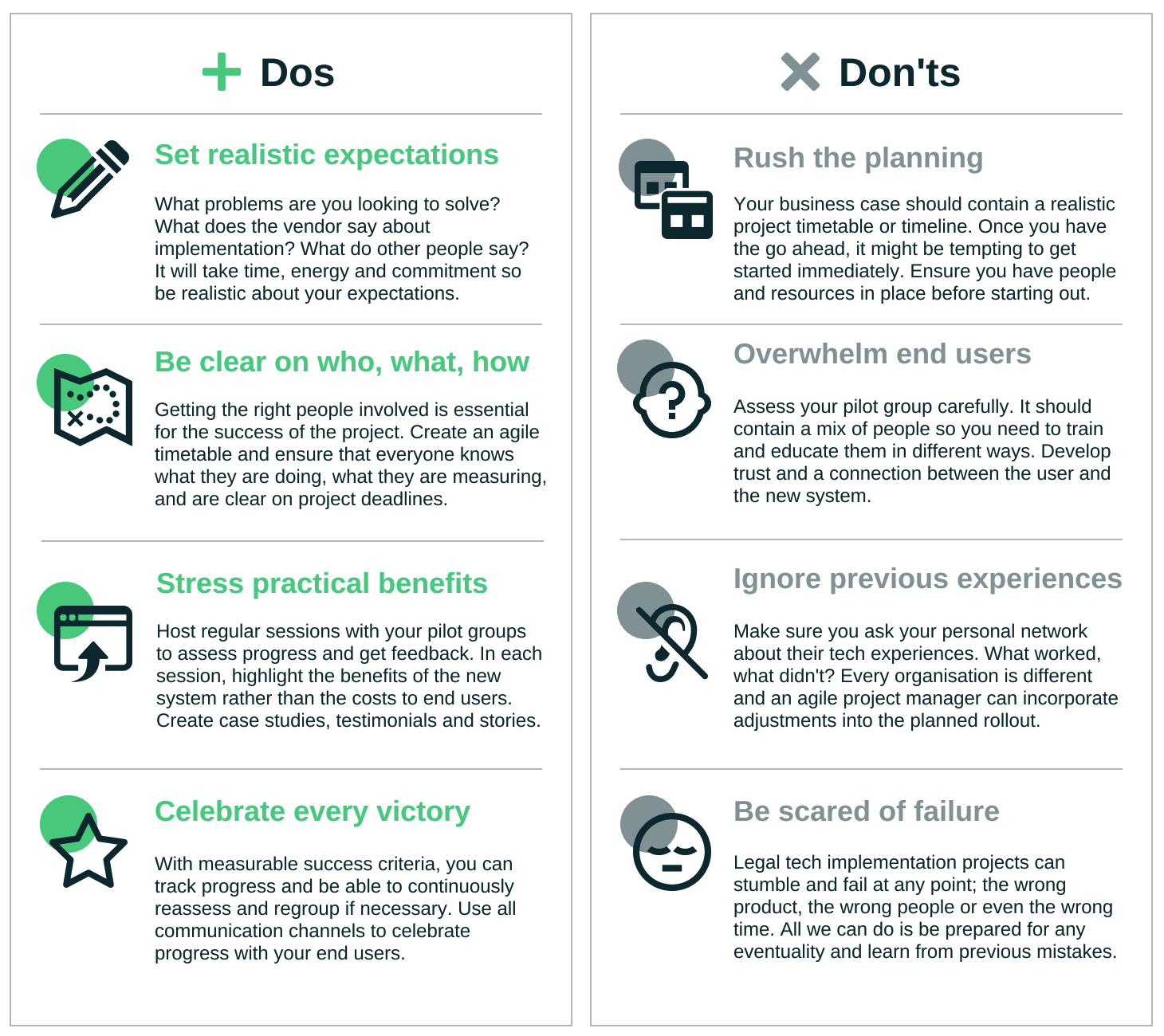Share this
Why tech implementation projects fail and what can you do to save them
November 1, 2022

Legal tech investment and expectations are at an all-time high. But how do you know the best ways to approach a tech implementation project to ensure success for you, your team, your end users and your clients? The more preparation and planning you do beforehand, you can avoid project pitfalls and be more certain of success.
Team Vable has worked with many law firms and in-house legal departments and we wanted to share some practical advice so that you can benefit from other people’s experiences. Read on for some thoughts about understanding the benefits of technology, how you go about getting your project started, mitigating the risk of failure and some real-life do’s and don’ts.
Understand the benefits of implementing new technologies
Finding a balance between the benefits and the costs in any tech implementation project is crucial. There has to be an open and transparent dialogue between the vendor and the customer. The vendor has to be honest about the investment of time and effort, and the customer has to allow for appropriate resources to ensure success.
For instance, with current awareness automation, people want to reduce time spent on manual processes and automating repetitive operations but it needs staff commitment and training to get it up and running. However, once this initial investment has been completed, end-users can reap the benefits and make the most of unexpected opportunities.
In short, lawyers and other end-users,
- Can improve their knowhow and stay up-to-date with current trends and developments
- Can ensure an uncluttered inbox
- Can enjoy standardised and professional alerts and newsletters
- Can improve both internal and external communication - standardising content and removing the fear of missing out
It’s not just current awareness workflows. Tech competency in all aspects of the business is essential to win and maintain clients. As the Wolters Kluwer survey says,
“the increased use of and investment in technology solutions continued in 2022…Law firms, confronted with changing client expectations, the demand for higher productivity and growing competition, are also turning to technology for help”.
Technology can “help” but you need to understand the specific and measurable benefits of whatever tech you are implementing - and what problem it will solve. You have to be clear as to why you are embarking on a project, and how it will impact you and your colleagues.
Getting started with your legal tech implementation project
Getting the right people involved is essential for the success of the project. For example, the case study session from the recent BIALL conference reminded us that project management expertise and assistance might be available from unexpected places in your organisation. Clearly, this is dependent on the culture of the organisation and its approach to tech rollouts.
I spoke at length with a project manager who rolled out Vable in their organisation. It became apparent that although an in-depth understanding of all the issues the organisation faced was essential, a project manager needs personality and drive. They explained the need to make the rollout fun and engaging, whilst maintaining control and purpose.
This project manager’s implementation plan had a strict timetable and ensured that the right people were included in the different parts of the process. As the plan progressed, they hosted regular sessions with their pilot group to assess progress and get feedback. In each session, they highlighted the benefits of current awareness excellence rather than the costs to end users!
And finally, this person told me that they needed to constantly measure the effectiveness of the ongoing rollout. Success stories, usage and other relevant metrics that demonstrate the implementation progress can be incorporated into roadshows and presentations to justify the investment of time and resources in ongoing technological investments and training programmes.
Learning from previous mistakes and managing the risk of failure
This project manager explained that even failures can be helpful. If something doesn’t go to plan, an agile project manager can incorporate adjustments into future iterations of the planned rollout. This is why despite failures, organisations may continue their tech implementation process and learn from them.
There are several ways to mitigate the risk of failure when implementing new technology and happily it has become the norm to talk about failures and learn from them. Related to this openness, a recent article asked for examples of legal tech failure for use in future articles, for instance, stating the following as food for thought;
- Software services failing to meet client expectations
- Poor project management
- Poor uptake of tech after implementation
Legal tech implementation projects can stumble and fail at any point; the wrong product, the wrong people or even the wrong time! All we can do is be prepared for any eventuality and take heed of the following do’s and don’ts, as taken from the conversation I had with the project manager.
Dos and don’ts of legal tech implementation projects

Final thoughts
All of the points above relate to the importance of putting the needs of your end users first. Without their interest and engagement, a project such as the automation of your current awareness will not be as successful as it should be. How we get people excited and turn them into champions will be influenced by the culture of the organisation and the personality and drive of the project manager.
Share this
- December 2025 (2)
- November 2025 (2)
- October 2025 (3)
- September 2025 (2)
- August 2025 (2)
- July 2025 (4)
- June 2025 (3)
- May 2025 (2)
- April 2025 (1)
- March 2025 (1)
- October 2024 (1)
- July 2024 (1)
- June 2024 (2)
- May 2024 (2)
- April 2024 (3)
- March 2024 (3)
- February 2024 (4)
- January 2024 (2)
- December 2023 (1)
- November 2023 (2)
- October 2023 (2)
- September 2023 (1)
- August 2023 (3)
- July 2023 (5)
- June 2023 (2)
- May 2023 (2)
- April 2023 (4)
- March 2023 (1)
- February 2023 (1)
- January 2023 (2)
- November 2022 (2)
- September 2022 (2)
- August 2022 (2)
- July 2022 (1)
- June 2022 (1)
- May 2022 (2)
- April 2022 (3)
- March 2022 (1)
- February 2022 (2)
- December 2021 (2)
- November 2021 (2)
- October 2021 (2)
- September 2021 (2)
- August 2021 (2)
- July 2021 (2)
- June 2021 (2)
- May 2021 (1)
- April 2021 (2)
- March 2021 (1)
- February 2021 (3)
- January 2021 (2)
- November 2020 (3)
- October 2020 (1)
- August 2020 (2)
- July 2020 (4)
- June 2020 (1)
- May 2020 (1)
- April 2020 (2)
- March 2020 (2)
- February 2020 (3)
- January 2020 (1)
- December 2019 (2)
- November 2019 (1)
- October 2019 (1)
- September 2019 (1)
- August 2019 (3)
- July 2019 (3)
- June 2019 (3)
- May 2019 (2)
- April 2019 (1)
- March 2019 (2)
- February 2019 (3)
- January 2019 (3)
- December 2018 (1)
- November 2018 (2)
- October 2018 (2)
- September 2018 (1)
- August 2018 (2)
- July 2018 (1)
- June 2018 (2)
- May 2018 (3)
- April 2018 (3)
- March 2018 (1)
- February 2018 (3)
- January 2018 (1)
- November 2017 (1)
- October 2017 (1)
- July 2017 (1)
- April 2017 (2)
- March 2017 (3)
- February 2017 (1)
- January 2017 (1)
- November 2016 (2)
- October 2016 (1)
- September 2016 (1)
- August 2016 (2)
- June 2016 (1)
- May 2016 (1)
- April 2016 (1)


